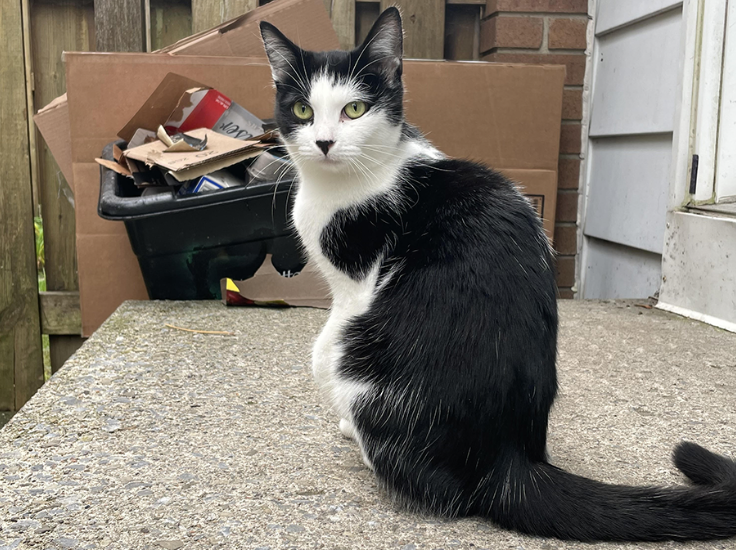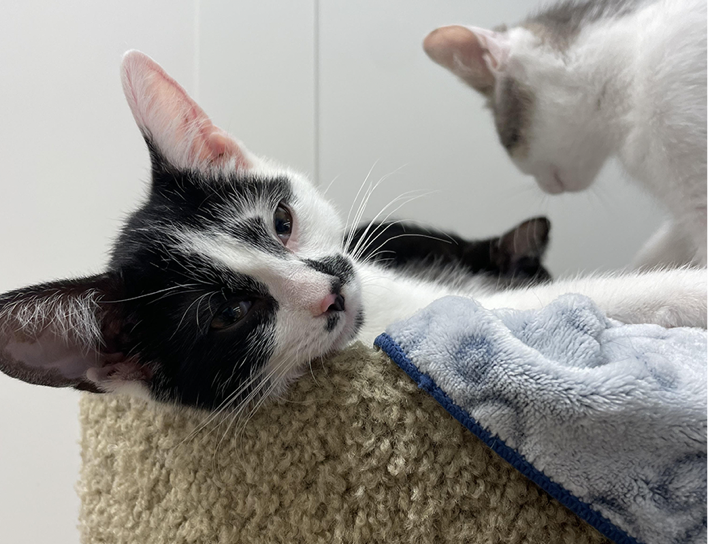Harley, a well-fed five-year-old cat, snarls and hisses at a coyote that has dared to set foot in his backyard. Harley is the fearless protector of Janice Richard’s home in Bells Corners — when he’s behind the protection of the back door.
“They would make lunch out of you,” Richard, who is Harley’s owner/rescuer, warns, not that he cares. Rescued as a kitten, Harley has never concerned himself with the dangers of coyotes.
But Harley is a lucky feline. Marta Burczycka, lead foster coordinator at Furry Tales Cat Rescue, says the operation is seeing up to 20 calls a day to take in stray and lost cats as winter approaches. Its harsh cold is particularly hard on pregnant females and newborn kittens.
Valerie Jerabek, volunteer coordinator with Ottawa Stray Cat Rescue (OSCatR), says more stray cats are found in higher density, low-income urban areas. And, Jerabek says, more people have become aware of the importance of reporting strays.
One of the main ways a cat becomes a stray is ‘cat dumping’ by an owner. Lost cats and non-sterilized cats add to the stray population.
Burczycka says some start when owners allow the animal outside but fail to monitor it. The cat will begin to come home less and eventually never returns at all.
All of which leads to overpopulation.
“One hundred per cent there is a cat overpopulation problem. A lot of times it’s hidden,” Burczycka says. The more time a cat spends away from humans, the more it learns not to trust them.
Pregnant cats are given top priority by rescue groups, as only 25 per cent of wild-born kittens survive, according to The Humane Society.
“For every pregnant cat that gives birth outside, if her kittens survive, that then becomes a big component to future cat overpopulation problems in that area,” Burczycka says.
Furry Tales adopts out around 1,000 cats annually to new permanent homes. Adopters are required to sign a contract, which includes a clause that states owners will never let the cats outside.
In colder weather, Burczycka says, dehydration, starvation, frostbite and predatory animals such as coyotes are the dangers for the strays.

“We see cats that come into care that have lived outside for years, and they’ll be missing some parts of their ears. Sometimes their entire ears are gone. They can get frostbite. … Kittens that are born outside late in the year … very often, won’t survive. They will actually freeze to death in the winter, or they’ll starve,” Burczycka said.
Burczycka recommends people able to help consider purchasing and leaving outside a heated water bowl, ensuring that strays have access. Additionally, she suggests leaving out kitten kibble, higher in nutritional value, to help strays maintain health.
OSCatR focuses on rescuing, rehabilitating and adopting stray cats. Jerabek says that OSCatR has taken in about 550 stray cats this year, with 126 currently in foster care. The rescue typically takes in 600-to-700 cats a year.
Trapping and Feral Relocation
OSCatR does trap-neuter-release (TNR), feral cat relocation and the general trapping of strays. The cat is assessed for adaptability to live with humans or is returned to its original environment.
Taking any cat off the street, whether a house cat or a stray, requires a trap, so trappers are a large part of any rescue. They use specialized cages designed to lure cats in and hold them until a human can deal with them. Trappers often spend extended periods of time on stakeouts, waiting for their target to enter a trap.
“Sometimes I’m gone for a two-week period. Eight or nine of those days, I’m gone. And it’s hard. It’s emotional. It is not easy work. Sometimes it’s pretty horrible,” says Janice Richard, who, aside from sheltering Harley, has been an Ottawa trapper for 22 years. Rescues often team up with experienced trappers like Richard. However, anyone with the necessary knowledge and skills can trap stray cats.
Richard says the trap has to be constantly watched.
“Trapping is very traumatic for a cat.” Without supervision there is also the risk that the cat will escape before rescuers arrive on site.
Richard advises against releasing or allowing trapped cats to escape, as they become harder to trap again. She emphasizes the need to plan ahead and stay at the trap location until the target cat is caught.
Trapping is not always an option in the winter.
“It’s very, very cold for our volunteers to be out there. Sometimes you’re sitting there for hours waiting for a cat to go into a trap. You cannot leave a trap unattended. The cat could get injured by being left in the trap unattended.” Says Jarabek.
TNR involves the trapping of both stray and feral cats, “We trap them, we neuter them, we make sure that they’re healthy (before releasing them),” says Jerabek. These cats are often returned to their original location to prevent mass procreation within colonies, though sometimes feral cat relocations are necessary.
Jerabek says sometimes “we can’t take them back to their environment where we found them for a variety of reasons, maybe the house that they were living in was torn down. We have hoarding situations where we have picked up 30 or 40 cats from a particular environment and the house or property is no longer there.”
Fostering
OSCatR often places feral cats in barns or agricultural buildings where they can even help control rodent populations. Jerabek says that while this is ideal for displaced feral cats, finding farms willing to take them is challenging as most already have their own cats.
A more common method of the cat socialization and adoption process is temporarily housing them with a volunteer foster until they are adopted. The shelter environment is not the best environment for any animal. Fostering allows a cat to adapt to life on the inside.
It’s not always easy getting people to foster cats, however.

“When you’re rescuing the cats off the street, they have to have a place to go. So they have to have a rescue, which means they have to have a foster, which means they have to have funding, which is always problematic for any of the rescues here in Ottawa,” says Richard. She encourages more people who have the space to think about fostering a cat.
“The rescue will help you through the whole process. Some pay for all the food and the litter and everything for you. Some can’t afford to, but some do. So it’s just a matter of giving them a little time and some love.”
A stray cat and a feral cat are two very different felines.
Jerabek says, “A stray can be a friendly cat that is just out on the street, it may be shy, it may be scared, so it may take a while for it to adjust to being with humans and human touch.”
A feral cat, Burczycka says, “Is truly a wild animal … these are cats that have been living predominantly in rural areas … like an abandoned barn … cats that have been living there that haven’t had virtually any contact with humans.” Burczycka says that the word “feral” is often avoided in rescue, as it labels the cat as non-adoptable.




